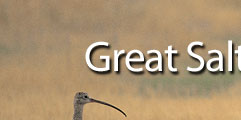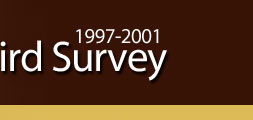The Great Salt Lake (GSL) Waterbird Survey (WBS) is a five-year study (1997-2001) that examines the relationships of migratory waterbirds with the GSL ecosystem through the spring, summer and fall seasons, between years, and across a variety of habitats. An important part of this ecosystem is the dynamic lake elevation, which during the study period ranged from 4,199.3’ to 4,204.6’ above sea level (ASL). This shift in water level causes dramatic changes in the availability and quality of habitat used by more than 55 species of waterbirds. During the study the high lake elevation was in 1999. As a result, many stands of emergent vegetation were inundated with lake water, and became salt burned.
|
As the lake receded to its lowest point during the study period in 2001, extensive mud bars void of vegetation were exposed. For five years researchers completed counts of waterbirds at GSL every ten days from April through September. The counts included the following families: Gaviidae, Podicipedidae, Pelecanidae, Phalacrocoracidae, Ardeidae, Threskiornithidae, Anatidae, Rallidae, Gruidae, Charadriidae, Recurvirostridae, Scolopacidae, Laridae. Avian use of the GSL ecosystem was measured by bird use days (one bird use day equals one bird spending 24 hours within the study area during the study period). The five year mean bird use days is 86,752,258. Bird use days for all GSL survey areas combined were lowest during the high water year (1999).
|















